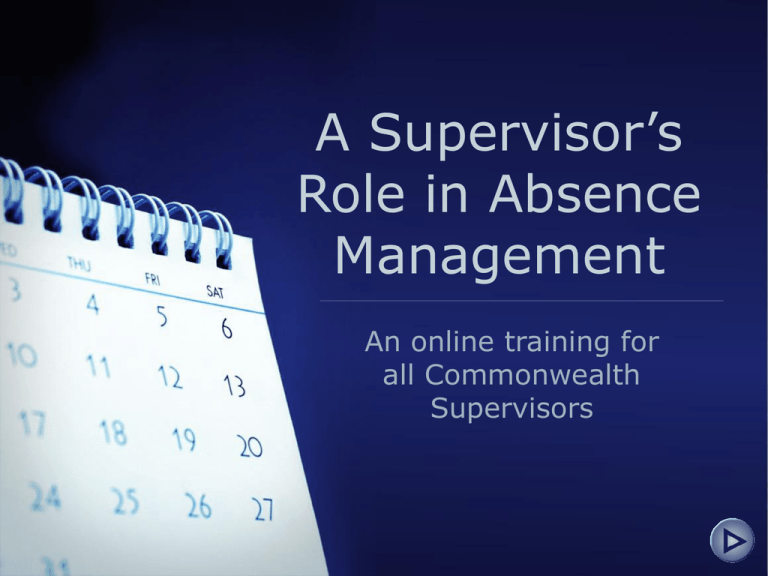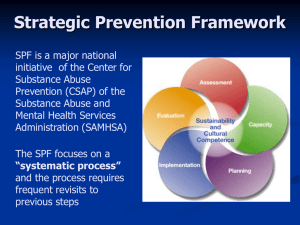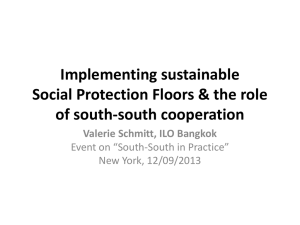A Supervisor's Responsibility for Absence Administration
advertisement

A Supervisor’s Role in Absence Management An online training for all Commonwealth Supervisors Welcome to this web-based training on Absence Administration. This course is for Commonwealth Supervisors. It will offer you an overview of your role in managing your employees’ absences. Course Sections This course is divided into the following four sections: Leaves of Absence 2. Absence Management 3. Roles related to Absences Sick, Parental, Family Care (SPF) Absences 1. 4. Navigation through this Course You will navigate through this course using the “back” ( ) and “next” ( ) buttons at the bottom of the screen. Knowledge Check At the end of the course there is a knowledge check that will test what you learned from this presentation. Classroom Course This is a basic course that offers an introduction to the topic of Absence Administration. After successfully completing this course, you will be enrolled in a classroom course that will explore this information in greater detail. This course will be scheduled by your Human Resources Office. Learning Objectives After completing this course, you should have a basic understanding of the following: Leaves of absence Absence management Roles related to absences Sick, Parental, Family Care (SPF) Absences Leaves of Absence Module #1 This module covers basic information that generally applies to all absences. Module #4 will explain Sick, Parental, and Family Care (SPF) absences, which don’t always follow all basic rules. Leaves of Absence In this module we will look at the basic concepts related to Leaves of Absence. A Leave of Absence is any time when an employee is absent from work, with or without compensation. Some Basic Rules All time away from work must be charged to and recorded with an appropriate leave type. Absence policies and procedures should be applied consistently. Absences should be requested in advance, unless circumstances do not permit. Emergency requests for all types of absence should be carefully considered. Any medical information provided verbally or in writing must be kept confidential. Most absence requests should be considered based on operational requirements. Types of Leaves of Absence Each type of leave has a unique absence code. There are many different types of leave, grouped into the following two categories: Accrued or Earned Leave Granted only for Qualifying Reasons Examples include: • Annual • Personal • Sick Examples include: • Leave Without Pay • Civil • Military Did you know that… Most absence requests may be disapproved for operational reasons. Exceptions to this include SPF Absences and Military Absences Approving Leaves of Absence All leaves of absence require approval/disapproval. Regardless of the type of leave, supervisors must not approve absences when the reason for the absence is either inappropriate or inconsistent with the policy. Resources for Information To make sure the reason for absence is consistent with the code, consult these resources: The applicable union contract Materials provided by the Human Resource Office Absence Types Guide Summary, found at www.SPFsupervisors.state.pa.us When in doubt, ask the Human Resource Office staff When a Supervisor Needs Guidance Supervisors should seek guidance from the Human Resource Office when they suspect employees are misusing leave or have unique circumstances that impact their leave use. Indicators of Employees Needing Guidance The following triggers may indicate that supervisors should notify or seek guidance from the Human Resource Staff: Employee is nearing the depletion of paid leave Employee requests an uncommon leave type Employee has an unscheduled absence for five or more consecutive work days Employee’s sick leave use has increased over the last few weeks or months A conversation is overheard or an employee tells the supervisor of a pregnancy or a serious health condition To Sum it Up: Leave must be requested for all time away from work. Generally, supervisors may disapprove absences due to operational reasons. Be sure to approve the correct absence code. Supervisors should seek guidance from their Human Resources Office in certain situations. Absence Management Module #2 The following slides review the concept of Absence Management. As in many situations, there are exceptions for which the basic rules do not apply. Some of these exceptions will be reviewed in Module #4. Absence Management – The Basics Both supervisors and employees have roles in Absence Management: Supervisors: Should consider employee requests for absences in relation to the need to maintain efficient operations (except when the absence is required by law or union contract to be approved). Employees: Should manage absences to not exceed accrued and/or anticipated leave balance quotas. Components of Absence Management Following are several ways that can help ensure effective Absence Management: Develop a call-off policy. Review absence and attendance policies – including the call-off policy – on an annual basis with all employees. Remind employees of absence management throughout the year if: call-offs are frequent, a lot of leave is used in relation to available leave, or accrued leave is nearly depleted. Counsel employees about effective use (or misuse) of leave when appropriate. Evaluate operational needs when considering each absence request and approve/deny it as appropriate. Apply absence policy and procedures consistently. To Sum it Up: Both supervisors and employees have roles related to absence management. Supervisors should evaluate operational needs when approving/denying absence requests. A well-communicated call-off policy and counseling when appropriate can help in effective absence management. Employees are responsible for managing their absences to not exceed accrued and/or anticipated leave balance quotas. Roles Related to Absence Management Module #3 The following slides outline roles and responsibilities in the administration of Absence Management. They cover the responsibilities of employees, supervisors, and Human Resource staff. Employee Responsibilities Employees have responsibility for the following components of Absence Management: Maintain and manage accrued and anticipated leave. Budget leave to last the entire year. Be aware that when accrued leave is depleted, additional absences may not be approved. Request absences in advance, when possible. Attempt to schedule absences when they are least disruptive to operations. Obtain/provide supporting documentation when required within requested timeframes. Adhere to established call-off procedures and work rules. Supervisor Responsibilities Supervisors have responsibility for the following components of Absence Management: Maintain efficient operations. Apply the call-off policy consistently. Ensure all absences are recorded. Ensure eligibility for the requested absence type by checking policies and leave balance quotas. Approve (or deny if appropriate) requests in a timely manner. Monitor employee absences and counsel employees about leave use as needed. Supervisor Responsibilities (continued) Follow labor agreement requirements for vacation selection. Approve absences consistent with operational needs on a first-come, first-serve basis, if requested outside of the vacation selection period. Carefully consider emergency requests. Remind employees annually of the absence management policies and their responsibility to manage/budget their absences. HR Office Responsibilities Time Advisors have responsibility for the following components of Absence Management: Ensure all employees receive orientation on absence provisions. Provide guidance to supervisors related to leave requests, including but not limited to: Correct absence coding Counseling employees about excessive leave use Monitor absence and other time-related error reports. HR Office Responsibilities SPF Coordinators have responsibility for the following components of Absence Management: Provide final approval or disapproval for SPF Absences. Determine employee eligibility and entitlement for SPF. Ensure absences are coded correctly. Monitor usage to ensure employees are not over-utilizing SPF Absence. Review medical documentation to ensure completeness and accuracy. Provide and request follow-up documentation as necessary. Assist employees and supervisors with SPF Absence requests. HR Office Responsibilities Labor Relations Coordinators have responsibility for the following components of Absence Management: Work with supervisors when leave restriction or discipline is necessary. Work closely with SPF Coordinator when issues overlap. To Sum it Up: Employees, Supervisors, Time Advisors, SPF Coordinators, and Labor Relations Coordinators all have roles related to managing absences. Sick, Parental, and Family Care (SPF) Absences Module #4 In this section we will review Sick, Parental, and Family Care (SPF) Absences in some detail. Some of the initial information in this section may be familiar to you if you have viewed the employee version of the SPF training. What is SPF Absence? An SPF Absence is a paid or unpaid absence from work with benefits for any of the following reasons: For the employee’s own incapacity or treatment due to a serious health condition as defined by the Family and Medical Leave Act (FMLA) of 1993; For a qualifying family member’s serious health condition when the employee is attending to the medical needs of the family member; or For the birth, adoption, or foster care placement of a child. Note: SPF Absence provisions do not apply to paid sick leave unless used for one of the reasons above. SPF and FMLA SPF Absences, in general, are covered by the Family and Medical Leave Act and are also designated as FMLA Leave under the provisions of FMLA. SPF Absence Applicability An SPF Absence is available and applicable to the following groups of employees effective January 1, 2008: Employees represented by unions : AFSCME PSSU (and UC Referees) UFCW SEIU-1199P ISSU PUC Attorneys OPEIU UGSOA LLEO FOSCEP Management and non-represented employees Note: Employees not covered above continue to follow existing policies for Sick, Parental, and Family Care leave without pay. SPF Absence Eligibility To be eligible for an SPF Absence, an employee must have: One year of service (26 pay periods of leave service credit) Worked 1250 hours in the twelve months preceding the first absence. Hours include: regular and overtime hours worked, and all hours of military absence Hours do not include: paid absences, unpaid absences, and holidays SPF Absence Eligibility Determination An employee’s eligibility is evaluated and determined for each new SPF event (which is a new or different medical condition or reason for using SPF absence). Employees remain eligible for each SPF event for one year, at which time eligibility is re-evaluated. SPF Absence Entitlement Once eligibility is determined, an employee is entitled to up to six months of SPF Absence within a rolling year for all SPF Absence events. Six months is: 982.5 hours for employees who work 7.5 hours/day 1,048 hours for employees who work 8 hours/day Prorated amount for part-time employees A rolling year is the 12-month period preceding the date of the absence. Note: When more than six months of paid leave is available, the entitlement is not limited to six months. SPF Absence Entitlement Intermittent or reduced-time use of SPF Absence is available only during the first 12 weeks of the sixmonth entitlement in a rolling year. Twelve weeks is: 450 hours for employees who work 7.5 hours/day 480 hours for employees who work 8 hours/day Prorated amount for part-time employees Paid SPF Absence All forms of paid leave used as SPF Absence reduce the six-month SPF Absence entitlement. All applicable accrued paid sick leave is required to be used. Accrued annual, personal, and holiday leave may be used. Anticipated annual, personal, and sick leave may be used in accordance with anticipation policies. All forms of paid leave, if required or if chosen to be used, must be taken before using unpaid SPF Absence. How does SPF relate to Absence Management? SPF Absence policy must be administered consistently. SPF Absences must be recorded correctly and timely. Despite a supervisor’s need to maintain efficient operations, no SPF Absence can be disapproved by the supervisor for operational reasons or for any other reason. All decisions for approval and disapproval are made by the SPF Coordinator. Absences must be provisionally approved/ designated as SPF/FMLA Absence within two business days. Additional Responsibilities related to SPF Absence In addition to standard Absence Management responsibilities, you have the additional responsibilities with SPF Absences: Comply with the FMLA law. Advise employees of their rights to use SPF Absence when absences are suspected to be qualifying. Monitor SPF entitlements to ensure that no leave is granted when an SPF entitlement has been depleted. Determine if call-offs should be designated as SPF Absence. Contact the SPF Coordinator for assistance and advice on all confirmed or possible SPF Absences. SPF Absence Do’s and Don’ts DO ensure that paid absences related to a serious health condition are coded as SPF Absence when appropriate. Note: Accrued sick leave is required to be used before any other paid or unpaid absence. DON’T ignore paid leave absences that may qualify as SPF Absence. Note: It is inappropriate to allow the use of paid leave and not report it as SPF Absence if it qualifies as SPF Absence. DON’T allow unpaid SPF Absence to be used simply because paid sick leave is depleted. Confidentiality An employee should submit all medical documentation related to their serious health condition to either the Human Resource Office or their supervisor. Supervisors should not review medical documentation, but should forward it directly to the Human Resource Office in an envelope marked “personal and confidential”. Supervisors should maintain confidentiality of any medical documentation or information the employee shares. Questions and More Information Each agency has a designated SPF Coordinator within the central Human Resource Office. This person is available to assist with any questions you may have about the SPF Absence policy. You can also visit the website, www.SPFsupervisors.state.pa.us, for additional information and forms for SPF Absences: Frequently Asked Questions Notice to Employees Request for SPF Absence Form Serious Health Condition Certification Form Future Training Classroom training will provide more specific information on SPF Absence and all other materials included in the presentation. For questions, contact your Human Resource Office. Knowledge Check You will now be taken to a knowledge check that will ask questions about the topics covered in this training. 1. What does SPF stand for? 1. 2. 3. 4. Sun Protection Factor Sick, Parental, and Family Care Sick Family, Prenatal, and Family Screening Prevention Forum Correct. "SPF" stands for Sick, Parental, and Family Care. Incorrect. "SPF" stands for Sick, Parental, and Family Care. 2. When a supervisor notices triggers - such as an employee nearing the depletion of their paid leave or an employee who uses more unscheduled absences than usual - the supervisor should: 1. 2. 3. Discipline the employee Notify or seek guidance from the Human Resources Office Talk to the employee's coworkers to find out if anyone knows about the employee's situation Correct. Supervisors should notify or seek guidance from their Human Resources Office when they have questions or need help managing their employees' leave. Incorrect. Supervisors should notify or seek guidance from their Human Resources Office when they have questions or need help managing their employees' leave. 3. Which of the following are components of effective Absence Management? 1. 2. 3. 4. Applying the call-off policy consistently Counseling employees about effective use of leave when it is appropriate Evaluating operational needs and approving or disapproving requested leave as appropriate All of the above Correct. All of these are components of effective Absence Management. Incorrect. All of these are components of effective Absence Management. 4. Which of the following individuals have roles in Absence Management? 1. 2. 3. 4. 5. 6. Employee Supervisor Time Advisor SPF Coordinator Labor Relations Coordinator All of the Above Correct. All of these individuals have roles in Absence Management. Incorrect. All of these individuals have roles in Absence Management. 5. True or False: SPF Absences, in general, are covered by the Family Medical Leave Act (FMLA) and are also designated as FMLA Leave under the provisions of the FMLA. 1. 2. True False Correct. Incorrect. 6. How much Commonwealth service must an employee have in order to be eligible for an SPF Absence? 1. 2. 3. 4. Three months Nine months One year Three years Correct. An employee must have one year of service and have worked 1250 hours in the twelve months preceding the first absence. Incorrect. An employee must have one year of service and have worked 1250 hours in the twelve months preceding the first absence. You have completed the Absence Management for Supervisors course. Thanks for being here!






